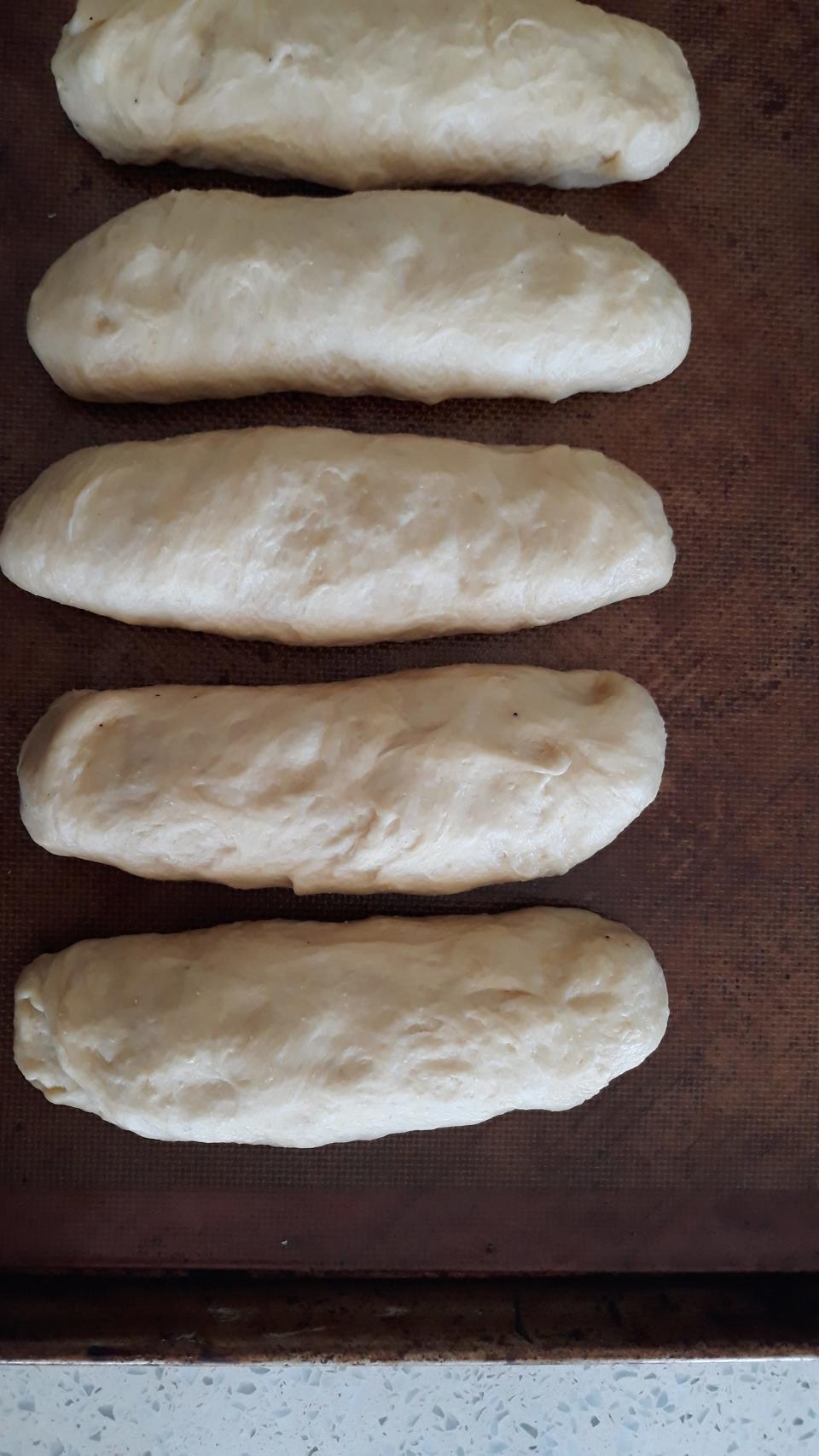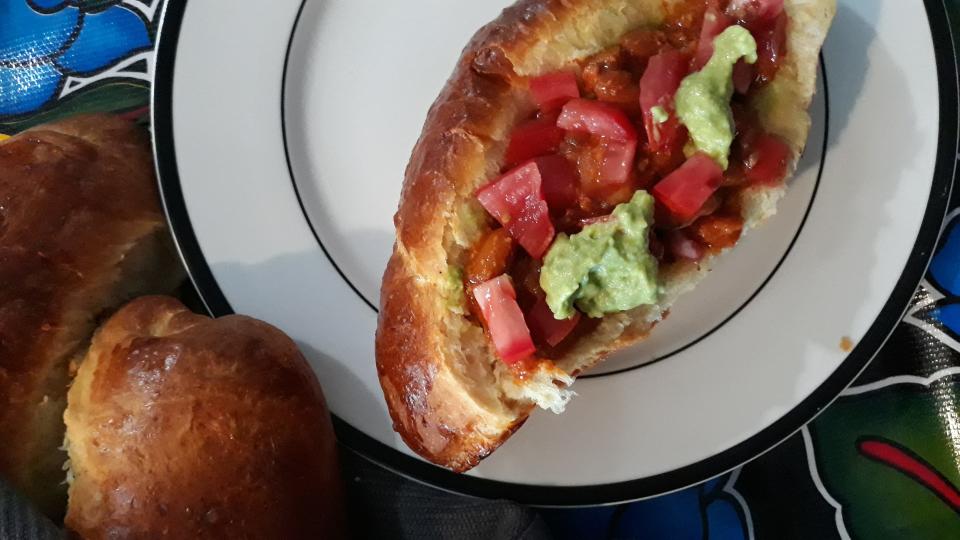The key to a great Sonoran hot dog is a great doggo bun. Here's how to make them
Sonoran doggos — the all beef hot dog, the bacon wrap, the lime mayo, avocado crema, caramelized onions or raw diced, pickled spicy mushrooms, carrots and jalapeño, chorizo beans, diced tomatoes, chiles güeros tatemados with crinkle cut fries on the side — tend to make an overloaded Chicago dog feel downright naked.
One foundational element of the Sonoran hot dog that is rarely given more than just a passing breath of attention is its foundation — the bun.
What makes a great Sonoran hot dog bun?
Soft and pillowy with a bit of sweetness, yet with the necessary tensile strength to carry the mass of toppings, the doggo bun is commonly mistaken for a bolillo. And while yes, the two breads resemble each other in size, they could not be more different in taste or consistency.
A water based dough, bolillos are satisfying in their simplicity, made with just flour, water, salt and yeast. They are one of the many baked goods that demonstrate the French influence on Mexican gastronomy, being a derivative of the lengthy baguette.
Slap a thick slab of butter and some cheese on a bolillo and you have simple perfection: a balance between creamy fat, dense crumb and crunchy crust which flakes off as you eat. This would be a recipe for disaster if a bolillo were asked to hold a fully-loaded doggo.
Enter the milk bun: Soft outside, soft inside, burnished golden brown with egg wash and elastic with the added richness of milk protein, which also helps it stay tender longer.
It’s a wonder of a bread, and the only correct vessel for a doggo.
Meet Minerva: Chef Orduño Rincón is here to teach you how to cook Sonoran-style

How to make a doggo milk bun
Matters such as the origin of the Sonoran hot dog, or what the proper toppings are, or even the debate as to whether the Ciudad Obregón style of doggos comes close to the original Hermosillo style, are mostly irrelevant if one doesn’t get the bread for it just right.
My recipe was developed to do just that and it begins with a tangzhong starter, a cooked flour and milk paste, which helps to add more moisture and structure to the dough.
It's not much different from making a roux, but without requiring a lengthy cooking time. The paste will carry over a small amount of heat into the dough, which is why this recipe uses the straight dough mixing method, which does away with blooming the yeast before incorporating into the remaining ingredients.
Speaking of yeast, it is best to avoid the single packages of dry active yeast. Opt instead for the jarred or vacuum sealed brick and be sure to store your yeast in the fridge or freezer to ensure freshness.
Always test a new batch of yeast to ensure it is alive and well.
For accuracy, baking recipes are frequently written using weight, rather than volume, and this one is no different. Grams are the unit of choice, as this is a Mexican recipe, after all!
Time to share: I guarded this 'secret' recipe for Sonoran chorizo for a decade
Recipe: Sonoran Doggo Buns

This doggo dough can be made by hand or with a mixer. There is no shame or prestige in one over the other, though there is a satisfying learning opportunity in kneading a dough to the correct tenderness by hand.
Makes: 8 buns
Ingredients:
For the tangzhong starter:
172 g (¾ cup) whole milk
28 g unbleached bread flour
For the dough:
600 g unbleached bread flour
75 g granulated sugar
12 g kosher salt
18 g dry active yeast
114 g butter, room temperature
2 large eggs
226 g (1 cup) whole milk, room temperature
For baking:
Baking tray
Parchment paper
1 egg
1 teaspoon water
Preparation:
Working in a small sauce pot, whisk together the milk and flour for the tangzhong until completely smooth.
Cook over low heat while continuously stirring, until a paste thick enough to stick to the sides of the pot forms, approximately 3 minutes. Allow to cool slightly.
In a large bowl, mix together the dough ingredients, starting with the dry ingredients, then incorporating the butter, followed by the eggs, then milk. Finally add the tangzhong.
Knead with either a mixer fitted with a dough hook or with the heel of your palm, either will produce the necessary kneading motion to stretch the dough and fold it over itself until a smooth elastic dough has formed. To test for correct gluten development, form the dough into a smooth ball, then gently press your thumb into the top. If the indentation remains, the dough is underworked. If the indentation bounces back most of the way, but retains a shallow dent, it is just right.
Place the dough in a lightly oiled bowl and turn to coat. Cover and rest until the dough has puffed up nicely, about an hour or hour and a half. The dough will be proofed to the correct level when a slight poke into the dough holds its shape.
Once proofed, turn out the dough on an unfloured surface (resist the urge to flour the working surface to prevent the dough from sticking. If needed, lightly oiling the hands will provide just enough oil to keep everything moving smoothly).
Divide dough into 8 equal portions and form them into smooth balls. Then roll each one into an even 5 ½-inch cylinder, about the length of a hot dog.
Line a baking tray with parchment paper. Place the dough cylinders on the tray abut a ½-inch apart and flatten slightly.
To proof, bring a small pot of water to a boil. Place the pot at the bottom of a cold oven. Place the bread tray on the center rack. Proof for approximately 50 minutes, or until noticeably poufy.
Remove the bread tray from the oven and preheat to 350°F.
Brush the tops of the buns with a wash consisting of 1 egg beaten well with 1 teaspoon water.
Bake until the dough reaches an internal temperature of 190 F and is heavily fragrant, approximately 20 to 25 minutes.
Cool the buns completely on a wire rack to prevent sogginess.
Once cool, separate the buns and cut a slit into the side, keeping the ends together. Fill as desired.
Store cooled buns in a paper bag for freshness.
This Sonoran chef hated making menudo: She discovered a better way to cook tripe
Questions or comments? Email the culinary team at cooking@azcentral.com. Follow chef Minerva Orduño Rincón on Instagram @cucumbersandlimes.
This article originally appeared on Arizona Republic: How to make Sonoran doggo buns: Easy recipe for Mexican hot dog buns

